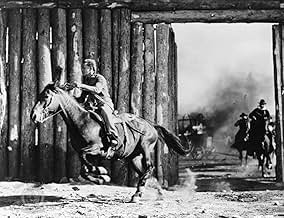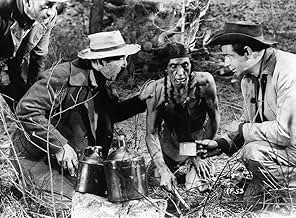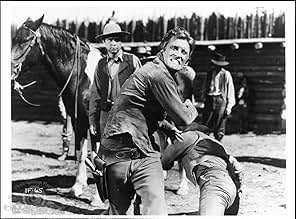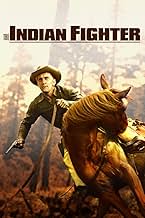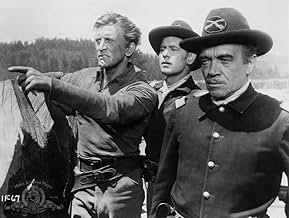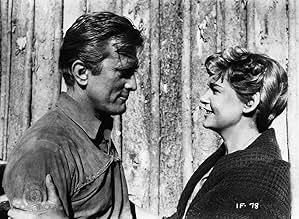VALUTAZIONE IMDb
6,3/10
3042
LA TUA VALUTAZIONE
Uno scout che guida una carovana attraverso l'ostile paese indiano viene involontariamente a che fare con la figlia di un capo Sioux.Uno scout che guida una carovana attraverso l'ostile paese indiano viene involontariamente a che fare con la figlia di un capo Sioux.Uno scout che guida una carovana attraverso l'ostile paese indiano viene involontariamente a che fare con la figlia di un capo Sioux.
- Regia
- Sceneggiatura
- Star
Lon Chaney Jr.
- Chivington
- (as Lon Chaney)
Alan Hale Jr.
- Will Crabtree
- (as Alan Hale)
Elisha Cook Jr.
- Briggs
- (as Elisha Cook)
Lane Chandler
- Head Settler
- (non citato nei titoli originali)
Robert 'Buzz' Henry
- Lt. Shaeffer
- (non citato nei titoli originali)
Recensioni in evidenza
It's called The Indian Fighter but oddly, in Andre de Toth's post Civil War western, Kirk Douglas playing Indian scout, Johnny Hawks, is the paleface who has the closest relationship with the local Sioux tribe and its leader Red Cloud. And while there appear to be quite a few native Americans doing their bit as tribal extras, the 4 main Indian roles are taken by 3 white guys and an Italian girl. To be fair I guess, it needs to be pointed out that the film is 66 years old, when prominent Native American actors weren't exactly a dime a dozen roaming Hollywood streets.
And Hollywood streets and backlots is not where The Indian Fighter was filmed. It's setting is Oregan and the movie makes particularly good use of the ruggedly scenic locations on tap and wisely even takes some time out for some diverting philosophic conversations, about the possibilities and long - term ramifications of a shrinking frontier.
Douglas's Hawks is not even your conventional western hero. He takes on more of an anti - hero status, with much of the dramatic content occurring as a direct result of him taking his eye off the ball for long periods, whilst being distracted by the charms of Red Cloud's daughter, Ohanti. Elsa Martinelli as Onahti is almost believable in the role, if you ignore her pronounced Italian accent. Anachronistically, she is also asked to act out one of those "Stop! Stop! I love it" routines which periodically reared their heads in 20th century movie - making, where the poor old, put upon female, is asked to put aside bullying, sexist male behaviour, in demonstrating she was actually receptive to it.
The narrative, whether deliberate or otherwise, ends up quite morally correctly, in the corner of the Indians. But everything is rather awkwardly put together. This includes the 2 cheesily, funny aquatic, nude scenes; one to introduce the character of Ohanti and the second to quite ludicrously finish, the film on an almost farcical note, with Hawks and Ohanti romping in the rapids together.
The Indian Fighter will be remembered as an entertaining vehicle for a somewhat over-acting Kirk Douglas, whilst attempting to portray Native Americans in a more positive light, but through a distinctly patronising means.
And Hollywood streets and backlots is not where The Indian Fighter was filmed. It's setting is Oregan and the movie makes particularly good use of the ruggedly scenic locations on tap and wisely even takes some time out for some diverting philosophic conversations, about the possibilities and long - term ramifications of a shrinking frontier.
Douglas's Hawks is not even your conventional western hero. He takes on more of an anti - hero status, with much of the dramatic content occurring as a direct result of him taking his eye off the ball for long periods, whilst being distracted by the charms of Red Cloud's daughter, Ohanti. Elsa Martinelli as Onahti is almost believable in the role, if you ignore her pronounced Italian accent. Anachronistically, she is also asked to act out one of those "Stop! Stop! I love it" routines which periodically reared their heads in 20th century movie - making, where the poor old, put upon female, is asked to put aside bullying, sexist male behaviour, in demonstrating she was actually receptive to it.
The narrative, whether deliberate or otherwise, ends up quite morally correctly, in the corner of the Indians. But everything is rather awkwardly put together. This includes the 2 cheesily, funny aquatic, nude scenes; one to introduce the character of Ohanti and the second to quite ludicrously finish, the film on an almost farcical note, with Hawks and Ohanti romping in the rapids together.
The Indian Fighter will be remembered as an entertaining vehicle for a somewhat over-acting Kirk Douglas, whilst attempting to portray Native Americans in a more positive light, but through a distinctly patronising means.
I've always enjoyed Kirk Douglas films in general and he's usually very good in westerns. But The Indian Fighter quite frankly is a pumped up B western.
Kirk produced this one as well and was able to get a good cast of familiar faces in westerns. He even got his ex-wife, Diana Douglas to appear as a widow traveling west on a wagon train with her son.
Kirk Douglas is Johnny Hawks who is a scout guiding a wagon train west to Oregon. The film opens with him checking out the naked Elsa Martinelli taking a bath in a creek. Pleasure before business and he continues on to the village where he finds out Elsa is the daughter of Chief Eduard Franz.
And that sets the tone for the film. When Douglas should be concerned about the safety of the people he's working for, he's off trying to court Elsa. His preoccupation with her almost causes disaster to the train.
Action there is though, including a nicely staged Indian attack on an army post. And the whole film was shot in Oregon on location quite nicely. I believe some of this same area was used in Kirk Douglas's later western The Way West.
Kirk Douglas's heroes are usually flawed and quite three dimensional. But this film has a hero I could not really get a rooting interest for.
Kirk produced this one as well and was able to get a good cast of familiar faces in westerns. He even got his ex-wife, Diana Douglas to appear as a widow traveling west on a wagon train with her son.
Kirk Douglas is Johnny Hawks who is a scout guiding a wagon train west to Oregon. The film opens with him checking out the naked Elsa Martinelli taking a bath in a creek. Pleasure before business and he continues on to the village where he finds out Elsa is the daughter of Chief Eduard Franz.
And that sets the tone for the film. When Douglas should be concerned about the safety of the people he's working for, he's off trying to court Elsa. His preoccupation with her almost causes disaster to the train.
Action there is though, including a nicely staged Indian attack on an army post. And the whole film was shot in Oregon on location quite nicely. I believe some of this same area was used in Kirk Douglas's later western The Way West.
Kirk Douglas's heroes are usually flawed and quite three dimensional. But this film has a hero I could not really get a rooting interest for.
At the heart of De Toth's oeuvre lies an interesting contradiction. He has an abiding interest in suspense, action, and the wellspring of violent events (a fact underlined by the number of thrillers, frontier yarns and dramas he helmed during his career), but, as a director, characteristically disassociates himself from their process. This 'distancing' effect has been noted by a number of viewers, creating some critical debate about De Toth's engagement with his material. In my view his detachment is not to be confused with aloofness - an interesting comparison can be made with Stanley Kubrick's alleged 'coldness' - but is rather De Toth's way of resolving what really 'matters'. It is this intelligence, revealing itself sharply in his best films, that makes him such a worthwhile study.
Along with De Toth's assured debut 'Ramrod' (1947) and the austere 'Day of the Outlaw' (1959), 'The Indian Fighter' is probably the finest of his Western films, revealing a characteristic response to the demands of the genre. In 'Ramrod' the moral questing springs from a noirish plot that is unsettled and full of tension. In 'Day of the Outlaw' issues are resolved more formally, played out against the stark landscape of Winter. In 'The Indian Fighter', De Toth's concerns manifest themselves in his most lyrical and sensuous work. He thereby creates a film which, in emphasis, is in direct contrast to most other 50's Westerns.
This is ostensibly a tale of a famous frontiersman Johnny Hawks (played with usual lusty gusto by Kirk Douglas), back from the wars. Ultimately he has to redeem his reputation, discovering balance within the indigenous people he has previously warred against. Gold has been discovered on Indian land, and the bad guys (a marvellous performance by Walter Matthau, ably supported by Lon Chaney, Jnr) are out to kill and cheat to secure the riches. This, and the related fear of a tribal uprising, provide the main action point of the film.
As the Indian fighter of the title, ironically the first thing we notice about Hawks is his reticence. In fact he hardly fights at all - only when he is obliged, or when called upon to at the climax of the film. For him, combat is not a prerequisite, although he is not slow to react when needs be. A comparison with the bitterness of Ethan Edwards, say, in Ford's 'The Searchers' is revealing. Edwards loathes the Commanches, with a bitterness entirely absence from De Toth's hero. As Hawks' opponents observe, he is more of an Indian lover than fighter. And, of course, in the most obvious way, they are right. Almost more important to the hero than his professional reputation is his preoccupation with the Indian maid Onhati. His single-minded pursuit, and later dalliance, with her initiates the main crisis of the film, as he leaves the wagon train to be by her side, after taking it 'two days out of my way and half way up a mountain'.
This is a film full of sensuality, placed in contrast to 'duty', the calling of action. We are constantly reminded of the cool pools, green foliage, closeness of the earth, just as much as of the teachery and turmoil of the frontier. Franz Waxman's score is lyrical and evocative, frequently idyllic. The glorious cinematography gives nature's perpetual garden a pantheistic gloss, sometimes intense, and always resplendent. Just as the main film captures these images, so in mimicry does Briggs, a supposed protégé of civil war photographer Matthew Brady, who frequently accompanies Hawks. He is eager to capture the grandeur around him. His camera is as significant to us as it is to Hawks, who makes a point of rescuing it at one point (during the battle at the fort). An important minor character, Briggs emphasises the appreciation of the sublime and beautiful that the film invites. A couple of times De Toth pauses the action (once at the fort and then at the wagon train), to pan his camera for long seconds along sets and people, recording their place in the Oregon landscape. Like Briggs he wants to admire, and record.
A circular film, 'The Indian Fighter' begins with Hawks gazing at Onhati bathing naked in a pool. It ends with him joining her in the water, forming a happy couple. The whole world of action is thus enclosed by their bonding, their sensual preoccupation usurping the violent demands of Indian-white conflict.
The scenes between the two lovers caused a murmur at the time. Considered 'risque' for the conservative 50's Western, De Toth simply inserted them, and their sexual self-absorption, as entirely fitting his plan of things. What is more eyebrow-raising today is how he allowed the encounters between two lovers to backstage the expected intrigues of masculine action, and actually assume greater significance, reversing regular audience expectations. This stress, an essentially feminine one. is completely uncharacteristic of the Western at this time. Add to that a sympathetic view of Indians and nature conservation (the Indian Chief's environmental concerns are a main reason for his refusing to exploit the land with mining) and you have an excellent film - a career highlight of this greatly underrated director.
Along with De Toth's assured debut 'Ramrod' (1947) and the austere 'Day of the Outlaw' (1959), 'The Indian Fighter' is probably the finest of his Western films, revealing a characteristic response to the demands of the genre. In 'Ramrod' the moral questing springs from a noirish plot that is unsettled and full of tension. In 'Day of the Outlaw' issues are resolved more formally, played out against the stark landscape of Winter. In 'The Indian Fighter', De Toth's concerns manifest themselves in his most lyrical and sensuous work. He thereby creates a film which, in emphasis, is in direct contrast to most other 50's Westerns.
This is ostensibly a tale of a famous frontiersman Johnny Hawks (played with usual lusty gusto by Kirk Douglas), back from the wars. Ultimately he has to redeem his reputation, discovering balance within the indigenous people he has previously warred against. Gold has been discovered on Indian land, and the bad guys (a marvellous performance by Walter Matthau, ably supported by Lon Chaney, Jnr) are out to kill and cheat to secure the riches. This, and the related fear of a tribal uprising, provide the main action point of the film.
As the Indian fighter of the title, ironically the first thing we notice about Hawks is his reticence. In fact he hardly fights at all - only when he is obliged, or when called upon to at the climax of the film. For him, combat is not a prerequisite, although he is not slow to react when needs be. A comparison with the bitterness of Ethan Edwards, say, in Ford's 'The Searchers' is revealing. Edwards loathes the Commanches, with a bitterness entirely absence from De Toth's hero. As Hawks' opponents observe, he is more of an Indian lover than fighter. And, of course, in the most obvious way, they are right. Almost more important to the hero than his professional reputation is his preoccupation with the Indian maid Onhati. His single-minded pursuit, and later dalliance, with her initiates the main crisis of the film, as he leaves the wagon train to be by her side, after taking it 'two days out of my way and half way up a mountain'.
This is a film full of sensuality, placed in contrast to 'duty', the calling of action. We are constantly reminded of the cool pools, green foliage, closeness of the earth, just as much as of the teachery and turmoil of the frontier. Franz Waxman's score is lyrical and evocative, frequently idyllic. The glorious cinematography gives nature's perpetual garden a pantheistic gloss, sometimes intense, and always resplendent. Just as the main film captures these images, so in mimicry does Briggs, a supposed protégé of civil war photographer Matthew Brady, who frequently accompanies Hawks. He is eager to capture the grandeur around him. His camera is as significant to us as it is to Hawks, who makes a point of rescuing it at one point (during the battle at the fort). An important minor character, Briggs emphasises the appreciation of the sublime and beautiful that the film invites. A couple of times De Toth pauses the action (once at the fort and then at the wagon train), to pan his camera for long seconds along sets and people, recording their place in the Oregon landscape. Like Briggs he wants to admire, and record.
A circular film, 'The Indian Fighter' begins with Hawks gazing at Onhati bathing naked in a pool. It ends with him joining her in the water, forming a happy couple. The whole world of action is thus enclosed by their bonding, their sensual preoccupation usurping the violent demands of Indian-white conflict.
The scenes between the two lovers caused a murmur at the time. Considered 'risque' for the conservative 50's Western, De Toth simply inserted them, and their sexual self-absorption, as entirely fitting his plan of things. What is more eyebrow-raising today is how he allowed the encounters between two lovers to backstage the expected intrigues of masculine action, and actually assume greater significance, reversing regular audience expectations. This stress, an essentially feminine one. is completely uncharacteristic of the Western at this time. Add to that a sympathetic view of Indians and nature conservation (the Indian Chief's environmental concerns are a main reason for his refusing to exploit the land with mining) and you have an excellent film - a career highlight of this greatly underrated director.
I had noticed this video for rent several times, but had always thought that the cover photo showed Kirk Douglas with Natalie Wood. Much to my surprise, it turns out not to be Natalie at all, but someone far more unusual, Elsa Martinelli, someone it seems I know best as Charlton Heston's love interest in "The Pigeon That Took Rome", the slim but pleasant comedy from 1962.
In fact, this film is "introducing Elsa Martinelli", a fresh import from Italy at the time. Bell' Italia indeed. Elsa introduces herself to us in the opening scene by undressing completely to go for a quiet dip in the river. So it's going to be la dolce vita along the riverbank, it seems...
As the beautiful long-haired Indian maiden, Elsa finds herself teamed with Kirk, brandishing his chin and his triangular physique. The Wild West lives up to its name, not only with the Indians' fiery attack on the army fort, the film's climax, but also with the steamy roll in the "surf" by our two principals, a couple of years after "From Here to Eternity".
The film offers Elisha Cook an unusual part to play, a photographer who had worked with Matthew Brady during the War, and who now wants to immortalize the West with his camera as advertising to attract settlers. The film understands the dichotomy of preservation and destruction that his character represents.
Walter Matthau and Lon Chaney are the bad white men, while Alan Hale (Gilligan's Skipper) and Frank Cady (Green Acres' Mr. Drucker) round out a nostalgic supporting cast.
Produced by Kirk Douglas's own production company, Bryna, "The Indian Fighter" can't help but have a social conscience. It does show the strong influence of the message Western -- in its interracial romance, Cook's proto-Ansel Adams character, and so on -- but without sacrificing the adventure elements of the story.
The film boasts some spectacular Oregon scenery. It's not the Monument Valley desert landscape we're used to seeing in so many other epic Westerns when directed by John Ford, but rather mountainous and riverine terrain, more like what Ford showed us in "How the West Was Won" (1962).
André De Toth provides good solid Cinemascope direction, letting the widescreen process work its own wonders on the audience. The film however does betray more brutality than I would have expected, especially for its day.
All in all, an adventure story intelligently and attractively handled, with some depth for those who care to look.
In fact, this film is "introducing Elsa Martinelli", a fresh import from Italy at the time. Bell' Italia indeed. Elsa introduces herself to us in the opening scene by undressing completely to go for a quiet dip in the river. So it's going to be la dolce vita along the riverbank, it seems...
As the beautiful long-haired Indian maiden, Elsa finds herself teamed with Kirk, brandishing his chin and his triangular physique. The Wild West lives up to its name, not only with the Indians' fiery attack on the army fort, the film's climax, but also with the steamy roll in the "surf" by our two principals, a couple of years after "From Here to Eternity".
The film offers Elisha Cook an unusual part to play, a photographer who had worked with Matthew Brady during the War, and who now wants to immortalize the West with his camera as advertising to attract settlers. The film understands the dichotomy of preservation and destruction that his character represents.
Walter Matthau and Lon Chaney are the bad white men, while Alan Hale (Gilligan's Skipper) and Frank Cady (Green Acres' Mr. Drucker) round out a nostalgic supporting cast.
Produced by Kirk Douglas's own production company, Bryna, "The Indian Fighter" can't help but have a social conscience. It does show the strong influence of the message Western -- in its interracial romance, Cook's proto-Ansel Adams character, and so on -- but without sacrificing the adventure elements of the story.
The film boasts some spectacular Oregon scenery. It's not the Monument Valley desert landscape we're used to seeing in so many other epic Westerns when directed by John Ford, but rather mountainous and riverine terrain, more like what Ford showed us in "How the West Was Won" (1962).
André De Toth provides good solid Cinemascope direction, letting the widescreen process work its own wonders on the audience. The film however does betray more brutality than I would have expected, especially for its day.
All in all, an adventure story intelligently and attractively handled, with some depth for those who care to look.
Kirk Douglas is portrayed as a lovable jack-the-lad here, always ready to fight for right. He's got a winning quip, a twinkle in his eye and a heart of a lion. I beg to differ.
For starters, right at the beginning he sees an Indian squaw he likes, taking a bath in a lake. So what does he do? Forget about roses or chocolates... he virtually ASSAULTS her to get a kiss, and then steals her knife into the bargain. Later on, he does the exact same thing. Guess what... this brutish behaviour actually makes her FALL IN LOVE with the maniac, and she has sex with him in the forest (only implied though... this WAS made in 1955 after all). This infatuation also causes him to divert a wagon train of white folk on a two day detour from their destination into hostile Indian territory... just so he can sneak a peek at her. This leads to a huge fight, in which many lives are lost on both sides. Some 'hero'.
If you ignore the movie's celebration of this psycho, and the dubious underlying message that we should all resort to Stone Age methods to get the girl of our dreams, there is quite a bit to enjoy here. Full scale battles, majestic cinematography, a compelling story, the works. There are amusing supporting characters, including a young guy who wants to photograph the whole Wild West with his newfangled invention known as a 'camera', and a tough widow with a little boy who is constantly proposed to by a boring fertiliser-obsessed farmer. Sadly for him, her affections (which remain unrequited) lie with Kirk Douglas... and even more bafflingly, her son idolises this lunatic too. Suddenly, soil is starting to seem more appealing by the minute...
So, yeah. Not a classic, but a rousing enough spectacle. With a protagonist I love to hate. Next... 6/10
For starters, right at the beginning he sees an Indian squaw he likes, taking a bath in a lake. So what does he do? Forget about roses or chocolates... he virtually ASSAULTS her to get a kiss, and then steals her knife into the bargain. Later on, he does the exact same thing. Guess what... this brutish behaviour actually makes her FALL IN LOVE with the maniac, and she has sex with him in the forest (only implied though... this WAS made in 1955 after all). This infatuation also causes him to divert a wagon train of white folk on a two day detour from their destination into hostile Indian territory... just so he can sneak a peek at her. This leads to a huge fight, in which many lives are lost on both sides. Some 'hero'.
If you ignore the movie's celebration of this psycho, and the dubious underlying message that we should all resort to Stone Age methods to get the girl of our dreams, there is quite a bit to enjoy here. Full scale battles, majestic cinematography, a compelling story, the works. There are amusing supporting characters, including a young guy who wants to photograph the whole Wild West with his newfangled invention known as a 'camera', and a tough widow with a little boy who is constantly proposed to by a boring fertiliser-obsessed farmer. Sadly for him, her affections (which remain unrequited) lie with Kirk Douglas... and even more bafflingly, her son idolises this lunatic too. Suddenly, soil is starting to seem more appealing by the minute...
So, yeah. Not a classic, but a rousing enough spectacle. With a protagonist I love to hate. Next... 6/10
Lo sapevi?
- QuizKirk Douglas did most of his own horseback riding and, at one point, broke his nose attempting a stunt that called for him to make his horse fall. Instead of leaning back in the saddle when yanking the horse's head around to the side, Douglas leaned forward and took the full force of the horse's heavy head right in the face. Bill Williams was Douglas' stunt double, and "was an excellent rider [he was later killed doing a stunt for La carovana dell'alleluia (1965)], and in silhouette looked a lot like me."
- BlooperRight before the Indians tie Todd to the tree with the intention of burning him, he's having a conversation with Johnny. During this conversation, Johnny's left arm repeatedly changes positions, from being stretched out against the tree, to holding his hat in front of him and back to stretched out against the tree.
- Citazioni
Grey Wolf: There can be no friendship between Red Man and White. The fight is to the end. Ride back to your people. There is no room for you here.
Johnny Hawks: You've grown a big mouth since I saw you last, Grey Wolf, but I didn't come here to talk to a big mouth. I've come to talk to a big man.
- ConnessioniReferenced in I soliti ignoti (1958)
I più visti
Accedi per valutare e creare un elenco di titoli salvati per ottenere consigli personalizzati
- How long is The Indian Fighter?Powered by Alexa
Dettagli
Botteghino
- Lordo Stati Uniti e Canada
- 2.450.000 USD
- Tempo di esecuzione1 ora 28 minuti
- Proporzioni
- 2.35 : 1
Contribuisci a questa pagina
Suggerisci una modifica o aggiungi i contenuti mancanti


